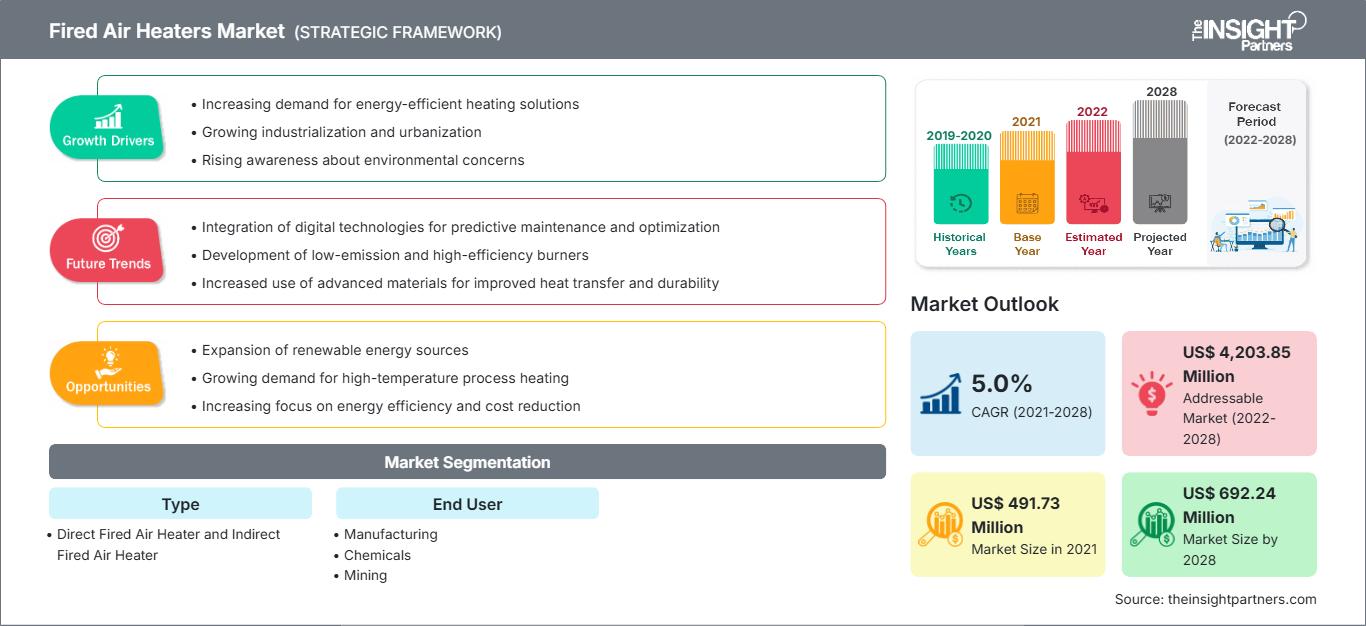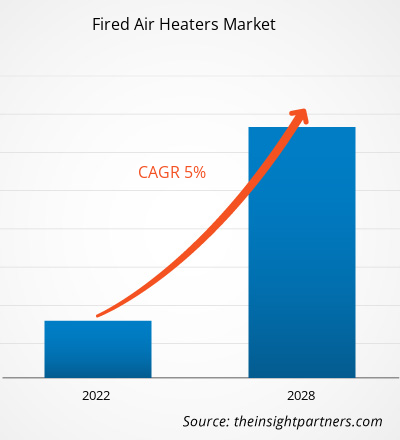燃焼式エアヒーター市場は、2021年の4億9,173万米ドルから2028年には6億9,224万米ドルに成長すると予想されており、2021年から2028年にかけて5.0%のCAGRで成長すると推定されています。
新興国における産業用途の加熱機器の需要増加は、燃焼式エアヒーター市場の主要な原動力となっています。燃焼式エアヒーターの必要性は、中国、インド、日本、ブラジルなどの新興経済国の企業からのエネルギー需要の増加によって推進されています。さらに、始動時間が短く、効率が高く、信頼性が高いため、製造、発電、加工における燃焼式エアヒーターの需要が増加しています。さらに、発電能力への投資の増加も、燃焼式エアヒーターのもう一つの原動力となっています。数十年にわたる製品製造技術の進歩により、燃焼式エアヒーターの需要は大幅に拡大し続けています。
燃焼式エアヒーターは、ガスや液体を特定の温度に加熱するために、加工業界で広く使用されています。さらに、燃焼式エアヒーターへのIoT(モノのインターネット)の統合により、燃焼式エアヒーターの採用が増加し、予測期間中の市場成長が促進されると考えられます。
要件に合わせてレポートをカスタマイズ
レポートの一部、国レベルの分析、Excelデータパックなどを含め、スタートアップ&大学向けに特別オファーや割引もご利用いただけます(無償)
燃焼式エアヒーター市場: 戦略的洞察

-
このレポートの主要な市場動向を入手してください。この無料サンプルには、市場動向から見積もりや予測に至るまでのデータ分析が含まれます。
COVID-19パンデミックによる燃焼式エアヒーター市場への影響
COVID-19パンデミックは世界に大きな影響を与え、多くの国を混乱させ続けています。COVID-19の発生まで、燃焼式エアヒーター業界は生産面で大幅な成長を遂げていました。しかし残念なことに、COVID-19の発生は、航空機メーカーの受注量が大幅に減少し、生産数も減少したことを反映し、世界中のさまざまな業界で燃焼式エアヒーターの需要を壊滅させました。生産量の減少は、さまざまな部品メーカーの事業や関連技術に悪影響を及ぼしました。さらに、建設、自動車、鉱業などのエンドユーザーの弱体化も市場の活力を失わせました。このように、燃焼式エアヒーター市場のプレーヤーの事業は、生産の不安定化によって深刻な影響を受けています。COVID-19ウイルスの蔓延により、建設業界全体が将来を予見するためのリソースが最小限に抑えられ、停止状態に陥りました。米国、フランス、ロシア、中国の複数の生産拠点は、ロックダウンと物理的距離に関する政府の規則を遵守するため、一時的に停止されました。建設業界では、新規プロジェクトに対する需要が20~30%減少しました。さらに、進行中の建設プロジェクトの停止も市場をさらに弱体化させました。この要因は、燃焼式エアヒーター市場に悪影響を及ぼしました。
燃焼式エアヒーター市場インサイト
産業用暖房機器の需要増加
ボイラー、ヒートポンプ、炉は、化学、食品、建設、鉱業などの業界で生産プロセスを実行するために使用される産業用暖房機器です。ボイラーは、水または他の液体を加熱して蒸気を発生させる密閉容器で、高圧下で吐出されて機械を駆動するために使用されます。また、ヒートポンプは、暖かい場所または冷たい場所に熱を伝達する装置です。さらに、炉はセントラルヒーティングシステムに不可欠なコンポーネントです。アミンおよびグリコール再沸器では、炭化水素蒸気から腐食性の硫化水素と二酸化炭素ガスを除去してから、それぞれの燃料を貯蔵または天然ガスおよび原油精製パイプラインに導入する必要があります。天然ガス蒸気と同様に、グリコールは天然ガスを流通させる前に水分を除去するために使用されます。メンテナンス費用が安く、構造がシンプルなため、このタイプのヒーターは天然ガス、原油、およびプロセス分野で使用されています。化学プロセス分野では、燃焼ヒーターがプロセス流体の加熱と蒸気生成に広く使用されています。
多くの場合、プロセス産業では燃焼ヒーターが最も多くのエネルギーを消費します。この調査では、垂直管を備えた箱型ヒーターが炭化水素流体の加熱に使用されます。鉱業では、燃焼空気ヒーターの特殊な用途である溶出ヒーターが使用され、独自の設計が求められます。溶出とは、分析化学および有機化学において、溶媒で洗浄することにより、ある物質を別の物質から抽出するプロセスであり、ほとんどの場合、加熱が行われます。金などの鉱物は交換器を用いて抽出されます。熱交換器の片側にはミネラルと溶剤の溶液が循環し、もう片側には熱伝達流体(一般的には熱媒液)が流通します。食品業界、特にフライ工程(ジャガイモ、スナック菓子、調理済み食品など)では、熱媒液ヒーターが用いられます。熱媒液ヒーターでは、装置内で加熱された熱媒液が循環し、その熱が熱交換器を通して上部の製品を揚げる油に伝達されます。鉱山の溶出プロセスに類似した設備がいくつか設置されており、揚げ油がボイラーを直通して循環し、その後ボイラーが加熱空気ヒーターとして使用されます。直火ヒーターは、石油化学業界では熱媒液ヒーターまたは間接ヒーターとして使用されることがあります。化学工場や製油所における直火ヒーターのメンテナンスサービスの良好な運用とスペアパーツの均一性が、熱媒液ヒーターの普及の主な理由です。熱媒液ヒーターは、その特定の機能における利点で定評があります。このように、様々な産業用途における加熱機器の需要増加が、燃焼式エアヒーター市場を牽引しています。
タイプ別市場分析
燃焼式エアヒーター市場は、タイプ別に直火式エアヒーターと間接式エアヒーターに分類されています。直火式ヒーターは、天然ガスまたはプロパンガスなどの適切な空燃比を維持することで、産業環境を安全に加熱する手段を提供します。直火式ヒーターでは、ガスがバーナーに直接供給され、空気流が燃焼に必要な酸素を供給します。ガスはバーナーバッフルを通過する空気と混合されます。バーナーは空気流と並行して燃焼するように設定されています。燃料の約100%が熱に変換されるため、燃料消費量とランニングコストが削減されます。
暖房機市場
The Insight Partnersのアナリストは、予測期間を通じて燃焼式エアヒーター市場に影響を与える地域的な傾向と要因を詳細に解説しています。このセクションでは、北米、ヨーロッパ、アジア太平洋、中東・アフリカ、中南米における燃焼式エアヒーター市場のセグメントと地域についても解説します。
燃焼式エアヒーター市場レポートのスコープ
| レポート属性 | 詳細 |
|---|---|
| の市場規模 2021 | US$ 491.73 Million |
| 市場規模別 2028 | US$ 692.24 Million |
| 世界的なCAGR (2021 - 2028) | 5.0% |
| 過去データ | 2019-2020 |
| 予測期間 | 2022-2028 |
| 対象セグメント |
By タイプ
|
| 対象地域と国 |
北米
|
| 市場リーダーと主要企業の概要 |
|
燃焼式空気加熱器市場のプレーヤー密度:ビジネスダイナミクスへの影響を理解する
暖房機市場は、消費者の嗜好の変化、技術の進歩、製品の利点に対する認知度の高まりといった要因により、エンドユーザーの需要が高まり、急速に成長しています。需要の増加に伴い、企業は製品ラインナップの拡充、消費者ニーズへの対応、新たなトレンドの活用を進めており、これが市場の成長をさらに加速させています。

- 入手 燃焼式エアヒーター市場 主要プレーヤーの概要
空気加熱器市場で事業を展開している企業は、合併、買収、市場開拓などの戦略を採用することで、市場での地位を維持しています。主要企業による動向をいくつかご紹介します。
- 2018年、Allmand Bros. Inc.(80年の歴史を持つ高性能ポータブル現場機器メーカーで、Briggs & Stratton Corporationの子会社)は、ネブラスカ州ホールドレージにある現在の施設を拡張し、新技術による製造能力の向上と市場投入までの期間の短縮を実現しました。
- 2018年、サーマルオイルヒーターの設計・製造におけるリーダー企業であるPiroblocは、米国に子会社を設立しました。 Pirobloc USA はすでに現実のものであり、完全に稼働しています。
世界の燃焼式エアヒーター市場は、次のように区分されています。
燃焼式エアヒーター市場 – タイプ別
- 直接燃焼式エアヒーター
- 間接燃焼式エアヒーター
燃焼式エアヒーター市場 – エンドユーザー別
- 製造業
- 化学薬品
- 鉱業
- 倉庫
- 石油・ガス
- 医薬品
- その他
燃焼式エアヒーター市場 –地理別
- 北アメリカ
- 米国
- カナダ
- メキシコ
- ヨーロッパ
- ドイツ
- フランス
- イタリア
- 英国
- ロシア
- その他の地域ヨーロッパ
- アジア太平洋 (APAC)
- オーストラリア
- 中国
- インド
- 日本
- 韓国
- アジア太平洋地域のその他の地域
- 中東およびアフリカ (MEA)
- 南アフリカ
- サウジアラビア
- UAE
- MEA のその他の地域
- 南アメリカ (SAM)
- ブラジル
- アルゼンチン
- SAM のその他の地域
会社概要
- ALLMAND BROS., INC
- Exotherm Corporation
- Hastings HVAC, Inc.
- SA ピロブロック
- SIGMA THERMAL, INC
- Stelter & Ltd. Brinck, Ltd.
- Tamarack Industries
- Therm Dynamics
- Wacker Neuson SE
- Zeeco, Inc
- 過去2年間の分析、基準年、CAGRによる予測(7年間)
- PEST分析とSWOT分析
- 市場規模価値/数量 - 世界、地域、国
- 業界と競争環境
- Excel データセット
最新レポート
関連レポート
お客様の声
購入理由
- 情報に基づいた意思決定
- 市場動向の理解
- 競合分析
- 顧客インサイト
- 市場予測
- リスク軽減
- 戦略計画
- 投資の正当性
- 新興市場の特定
- マーケティング戦略の強化
- 業務効率の向上
- 規制動向への対応






















 無料サンプルを入手 - 燃焼式エアヒーター市場
無料サンプルを入手 - 燃焼式エアヒーター市場